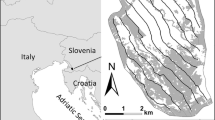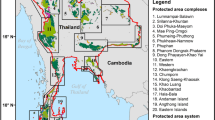Abstract
Agricultural land abandonment, widespread in the Mediterranean, is leading to a recovery of scrubland and forests which are replacing open habitats and increasing wildfire events. Using published data, we modelled the global and regional impact of abandonment and wildfires on 554 species of terrestrial vertebrates occurring in Mediterranean Europe. For all groups except amphibians, open habitats or farmland sustained higher species richness. Open habitats showed regional differences in their conservation value, western areas being particularly important for birds and amphibians and eastern areas for reptiles. Scrublands hosted fewer species than open habitats, farmland and forest, but sustained several endemic birds and mammals. The greater species richness of forests was mostly due to species widespread in Europe. Wildfires promote scrubland expansion in detriment of forest; because more species are associated to eastern forests, fire is predicted to affect more seriously this region. Scrubland conservation value was found to be highest in the west, where fire might have a positive impact. Fire regime, however, plays a crucial role. Although large fires have a negative impact, small-scale fires may favour biodiversity in abandoned areas. Due to the intrinsic difficulty in managing abandoned land to preserve the original Mediterranean vertebrate diversity, the best option to achieve this goal is the development of policies designed to make farmers and traditional farmland survive.







Similar content being viewed by others
References
Baldock D, Beaufoy G, Brouwer F, Gode-schalk F (1996) Farming at the margins: abandonment or redeployment of agricultural land in Europe. Institute for European Environmental Policy Agricultural Economics Research Institute, London, The Hague
Beaufoy G, Baldock D, Clark J (1994) The nature of farming. Low intensity farming systems in nine European countries. IEEP, London, UK
Benton TG, Vickery JA, Wilson JD (2003) Farmland biodiversity: is habitat heterogeneity the key? Trends Ecol Evol 18:182–188
Bignal EM, McCracken DI (1996) Low-intensity farming systems in the conservation of the countryside. J Appl Ecol 33:413–424
Blondel J, Aronson J (1999) Biology and wildlife of the Mediterranean region. Oxford University Press, Oxford, UK
Blondel J, Farré H (1988) The convergent trajectories of bird communities in European forests. Oecologia 75:83–93
Blondel J, Catzeflis F, Perret P (1996) Molecular phylogeny and the historical biogeography of the warblers of the genus Sylvia (Aves). J Evol Biol 9:871–891
Breitenmoser U (1998) Large predators in the Alps: the fall and rise of man’s competitors. Biol Conserv 83:279–289
Brotons L, Pons P, Herrando S (2005) Colonization of dynamic Mediterranean landscapes: where do birds come from after fire? Journal of Biogeography 32:789–798
Cavitt JF (2000) Fire and a tallgrass prairie reptile community: effects on relative abundance and seasonal activity. J Herpetol 34:12–20
Clutton-Brock J. (1999) A natural history of domesticated mammals. Cambridge University Press, UK
Covas R, Blondel J (1998) Biogeography and history of the Mediterranean bird fauna. Ibis 140:395–407
Dafni A, O’Toole C (1994) Pollination syndromes in the Mediterranean: generalisation and pecularities. In: Arianoutsou M, Groves RH (eds) Plant-animal interactions in Mediterranean ecosystems. Kluwer Academic Publishers, Dordrecht, pp 125–135
Delbaere B (2002) The impact of agricultural policies on biological diversity and landscape. Document prepared for the high-level Pan-European conference on agriculture and biodiversity: towards integrating biological and landscape diversity for sustainable agriculture in Europe. Maison de l’Unesco, Paris, 5–7 June 2002, p 25
Donald PF, Green RE, Heath MF (2001) Agricultural intensification and the collapse of Europe’s farmland bird populations. Proc R Soc Lond B Biol Sci 268:25–29
Donázar JA, Fernández C (1990) Population trends of the Griffon Vulture Gyps fulvus in Northern Spain between 1969 and 1989 in relation to conservation measures. Biol Conserv 53:83–91
EEA (2004) High nature value farmland. Characteristics, trends and policy challenges. EEA report, 1. European Environmental Agency, Copenhagen
Escriba LJ (1987) La guia INCAFO de los anfibios y reptiles de la Peninsula Iberica, Islas Baleares y Canarias. INCAFO, S.A., Madrid, Spain
Falcucci A, Maiorano L, Boitani L (2007) Changes in land-use/land-cover patterns in Italy and their implications for biodiversity conservation. Landscape Ecology 22:617–631
Farina A (1997) Landscape structure and breeding bird distribution in a sub-Mediterranean agroecosystem. Landsc Ecol 12:365–378
Fry GLA (1989) Conservation in agricultural ecosystems. In: Spellerberg IF, Goldsmith FB, Morris MG (eds) The scientific management of temperate communities for conservation. Blackwell Science, Southampton, pp 415–443
Gasc JP, Cabela A, Crnobrnja-Isailovic J, Dolmen D, Grossenbacher K, Haffner P, Lescure J, Martens H, Martínez Rica JP, Maurin H, Oliveira ME, Sofianidou TS, Veith M, Zuiderwijk A (eds) (1997) Atlas of amphibians and reptiles in Europe. Collection Patrimoines Naturels 29, Paris, France
Hagemeijer EMJ, Blair MJ (eds) (1997) The EBCC atlas of European breeding birds: their distribution and abundance. T & AD Poyser, London, UK
Haydon DT, Friar JK, Pianka ER (2000) Firedriven dynamic mosaic in the Great Victoria Desert, Australia. 1. Fire geometry. Landsc Ecol 15: 373–381
Henderson IG, Wilson AM, Steele D, Vickery JA (2002) Population estimates, trends and habitat associations of breeding Lapwing Vanellus vanellus, Curlew Numenius arquata and Snipe Gallinago gallinago in Northern Ireland in 1999. Bird Study 49:17–25
Herrando S, Brotons L, Llacuna S (2003) Does fire increase the spatial heterogeneity of bird communities in Mediterranean landscapes? Ibis 145:307–317
Huntley, B (1988) European post-glacial vegetation history: a new perspective. In: Ouellet, H. (ed.) Acta XIX Congressus Internationalis Ornithologici, Vol. 1. National Museum of Natural Sciences, Ottawa, pp. 1061–1077
IUCN, Conservation International, and NatureServe (2004) Global amphibian assessment. http://www.globalamphibians.org. Downloaded 7 Feb 2005
Lloret F, Calvo E, Pons X, Diáz-Delgado R (2002) Wildfires and landscape patterns in the East European Peninsula. Landsc Ecol 17:745–759
Lockwood JA (1997) Rangeland grasshopper ecology. In: Gangwere SK, Muralirangan MC, Muralirangan M (eds) The bionomics of grasshoppers. Katydids and their kin. CAB International, Wallingford, pp 83–101
Martín J, Lopez P (2002) The effect of Mediterranean dehesa management on lizard distribution and conservation. Biol Conserv 108:213–219
Mitchell-Jones AJ, Amori G, Bogdanowicz W, Krystukef B, Reijnders PJH, Spitzenberger F, Stubbe M, Thissen JBM, Vohralík V, Zima J (1999) Atlas of European mammals. Academic, London, UK
Monimeau L, Mouillot D, Fons R, Prodon R, Marchand B (2002) Impact of prescribed burning on the survival rates of the wood mouse (Apodemus sylvaticus). Acta Oecologica 23:51–58
Moreira F, Ferreira PG, Rego FC, Bunting S (2001) Landscape changes and breeding bird assemblages in north-western Portugal: the role of fire. Landsc Ecol 16:175–187
Moreira F, Pinto MJ, Henriques I, Marques T (2005) Importance of low-intensity farming systems for fauna, flora and habitats protected under the European “Birds” and “Habitats” directives: is agriculture essential for preserving biodiversity in the Mediterranean region? In: Burk AR (ed) Trends in biodiversity research. Nova Science Publishers, New York, pp 117–145
Moreno JM, Vazquez A, Velez R (1998) Recent history of forest fires in Spain. In: Moreno JM (ed) Large forest fires. Backhuys Publishers, Leiden, pp 159–186
Moseley KR, Castleberry SB, Schweitzer SH (2003) Effects of prescribed fire on herpetofauna in bottomland hardwood forests. Southeast Nat 2:475–486
Mouillot F, Rambal S, Joffre R (2002) Simulating climate change impacts on fire frequency and vegetation dynamics in a Mediterranean-type ecosystem. Glob Change Biol 8:423–437
Mouillot F, Ratte J-P, Joffre R, Moreno J, Rambal S (2003) Some determinants of the spatio-temporal fire cycle in a Mediterranean landscape (Corsica, France). Landsc Ecol 18:665–674
Nagy S (2002) The status of biodiversity on farmland in Europe (birds). Document prepared for the high-level Pan-European conference on agriculture and biodiversity: towards integrating biological and landscape diversity for sustainable agriculture in Europe. Maison de l’Unesco, Paris, 5–7 June 2002
Ostermann O (1998) The need for management of nature conservation sites designated under Natura 2000. J Appl Ecol 35:968–973
Pedrini P, Sergio F (2001) Golden Eagle Aquila chrysaetos density and productivity in relation to land abandonment and forest expansion in the Alps. Bird Stud 48:194–199
Petit S, Maskell L, Smart S, Wright S (2003) MIRABEL II. Models for predicting the impact of terrestrial eutrophication farming intensification and land abandonment on biodiversity in European landscapes. Centre for Ecology and Hydrology and Natural Environment Research Council, Bangor
Pino J, Rodá F, Ribas J, Pons X (2000) Landscape structure and bird species richness: implications for conservation in rural areas between natural parks. Landsc Urban Plan 49:35–48
Pons P, Lambert B, Rigolot E, Prodon R (2003) The effects of grassland management using fire on habitat occupancy and conservation of birds in a mosaic landscape. Biodivers Conserv 12:1843–1860
Preiss E, Martin JL, Debussche M (1997) Rural depopulation and recent landscape changes in a Mediterranean region: consequences to the breeding avifauna. Landsc Ecol:51–61
Rego F (1992) Land use changes and wildfires. In: Teller A, Mathy P, Jeffers JNR (eds) Responses of forest ecosystems to environmental changes. Elsevier Applied Science, London, pp 367–373
Robinson RA, Sutherland W (2002) Post-war changes in arable farming and biodiversity in Great Britain. J Appl Ecol 39:157–176
Russo D (2007) The effects of land abandonment on animal species in Europe: conservation and management implications. Integrated assessment of vulnerable ecosystems under global change in the European Union. Project report. European Commission, Community Research, Sustainable development, global change and ecosystems
Shine R (2005) Life-history evolution in reptiles. Annu Rev Ecol Evol Syst 36:23–46
Söderström B, Pärt T (2000) Influence of landscape scale on farmland birds breeding in semi-natural pastures. Conserv Biol 14:522–533
Sokal RR, Rohlf FJ (1987) Biometry, 2nd edn. W.H. Freeman and Company, New York, USA
Stoate C, Boatman ND, Borralho RJ, Rio Carvalho C, de Snoo GR, Eden P (2001) Ecological impacts of arable intensification in Europe. J Environ Manage 63:337–365
Suàrez-Seoane, S, Osborne, PE, Baudry, J (2002) Response of birds of different biogeographic origins and habitat requirements to agricultural land abandonment in northern Spain. Biol Cons 105: 333–344
Taberlet P, Fumagalli L, Wust-Saucy A-G, Cosson J-F. (1998) Comparative phylogeography and postglacial colonization routes in Europe. Mol Ecol 7: 453-464
Taylor JE, Fox BJ (2001) Disturbance effects from fire and mining produce different lizard communities in eastern Australian forests. Austral Ecol 26:193–204
Tella LJ, Forero MG, Hiraldo F, Donàzar JA (1998) Conflicts between lesser kestrel conservation and European agricultural policies as identified by habitat use analyses. Conserv Biol 12:593–604
Tucker G (1997) Priorities for bird conservation in Europe: the importance of the farmed landscape. In: Pain D, Pienkowski M. (eds.) Farming and birds in Europe: The Common Agricultural Policy and its Implications for Bird Conservation. Academic Press, San Diego, pp. 79–116
Tucker GM, Heath MF (1994) Birds in Europe: their conservation status. BirdLife International (Conservation Series No. 3), Cambridge, UK
Turner M (1989) Landscape ecology: the effect of pattern on process. Annu Rev Ecol Syst 20:171–197
Turner MG, Hargrove WW, Gardner RH, Romme WH. (1994) Effects of fire on landscape heterogeneity in Yellowstone National Park, Wyoming. J Veg Sci 5: 731–742
Turner M, Romme WH (1994) Landscape dynamics in crown fire ecosystems. Landsc Ecol 9:59–77
Woinarski JCZ, Armstrong M, Price O, McCartney J, Griffiths AD, Fisher A (2004) The terrestrial vertebrate fauna of Litchfield National Park, Northern Territory: monitoring over a 6-year period and response to fire history. Wildl Res 31:587–596
Author information
Authors and Affiliations
Corresponding author
Rights and permissions
About this article
Cite this article
Moreira, F., Russo, D. Modelling the impact of agricultural abandonment and wildfires on vertebrate diversity in Mediterranean Europe. Landscape Ecol 22, 1461–1476 (2007). https://doi.org/10.1007/s10980-007-9125-3
Received:
Accepted:
Published:
Issue Date:
DOI: https://doi.org/10.1007/s10980-007-9125-3




